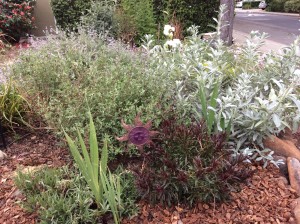Sometimes necessity is a larger motivator than entirely noble intentions. We found ourselves with an old pool which constantly generated more leaks than we could fix. We had never sought a pool in our house hunting in 2003, but this house had one and we figured we would keep it and see if we enjoyed having it. Pools in Northern California are only really usable June through August, and must be maintained with pool chemicals and leaf removal 12 months per year, so it became more trouble than it was worth. We decided to remove it.
We had our backyard overhauled in summer of 2013. The old wood decks were replaced with concrete pavers and the old pool was filled in and covered with artificial turf. The result is much more usable space in the yard with much lower maintenance and water usage. Our entire back yard, which used to be a water hog now has a small drip system for plants we have on the perimeter and on our patio.
During this makeover, we decided to rip out the front lawn as well, and replace it with California Natives and drought resistant plants. The plants were mostly purchased from the Native Plant society annual sale at Hidden Villa, along with plants from Summerwind Nursery in Mountain View. The Los Altos nursery also has water-wise plants. The design of the front yard space is simply a rock-formed planting circle surrounded by crushed granite and redwood bark, along with rounded river stones. The plants looked a little “out of scale” when they were first planted in October 2013, but they have all grown into nice bushes, mainly by being watered by rain water and a small drip system which was converted by using the previous lawn sprinklers. We saved additional water by upgrading our sprinkler controller to a RainBird unit which has a rain sensor, so that no watering is done on rainy days. The unexpected result of planting natives (many which flower) is that on any given nice day, there are bees buzzing in the planters, as well as butterflies, ladybugs and other beneficial insects. It is noticeable that this little space has abundantly more life than the lawns which are nearby.
The last thing we have done is put up a small greenhouse with an Aquaponics system inside. This system uses fish to provide waste which is converted to Nitrogen and other elements that plants need. The plants are planted in an inert growing media made of expanded clay, so there is no dirt involved. This system is now providing us tomatoes (in March) with the only inputs being fish food, sunlight and a tiny bit of water to replace the water which is respirated from the plant leaves and by evaporation. This system which provides food requires only about 15 gallons per week which is supporting the growth of 15 tomato plants, lettuce, beets, strawberries, kale and garlic.
Between removing the pool and the lawns, and replacing with artificial turf and low water plants, our water bill is less than half what it was in 2013. We are certainly glad we did it and we are happy to know we are doing our part to conserve water in Mountain View.


